The 2011 Mid-Range SSD Roundup: 120GB Agility 3, Intel 510 and More Compared
by Anand Lal Shimpi on June 7, 2011 12:52 PM ESTAnandTech Storage Bench 2011
I didn't expect to have to debut this so soon, but I've been working on updated benchmarks for 2011. Last year we introduced our AnandTech Storage Bench, a suite of benchmarks that took traces of real OS/application usage and played them back in a repeatable manner. I assembled the traces myself out of frustration with the majority of what we have today in terms of SSD benchmarks.
Although the AnandTech Storage Bench tests did a good job of characterizing SSD performance, they weren't stressful enough. All of the tests performed less than 10GB of reads/writes and typically involved only 4GB of writes specifically. That's not even enough exceed the spare area on most SSDs. Most canned SSD benchmarks don't even come close to writing a single gigabyte of data, but that doesn't mean that simply writing 4GB is acceptable.
Originally I kept the benchmarks short enough that they wouldn't be a burden to run (~30 minutes) but long enough that they were representative of what a power user might do with their system.
Not too long ago I tweeted that I had created what I referred to as the Mother of All SSD Benchmarks (MOASB). Rather than only writing 4GB of data to the drive, this benchmark writes 106.32GB. It's the load you'd put on a drive after nearly two weeks of constant usage. And it takes a *long* time to run.
I'll be sharing the full details of the benchmark in some upcoming SSD articles but here are some details:
1) The MOASB, officially called AnandTech Storage Bench 2011 - Heavy Workload, mainly focuses on the times when your I/O activity is the highest. There is a lot of downloading and application installing that happens during the course of this test. My thinking was that it's during application installs, file copies, downloading and multitasking with all of this that you can really notice performance differences between drives.
2) I tried to cover as many bases as possible with the software I incorporated into this test. There's a lot of photo editing in Photoshop, HTML editing in Dreamweaver, web browsing, game playing/level loading (Starcraft II & WoW are both a part of the test) as well as general use stuff (application installing, virus scanning). I included a large amount of email downloading, document creation and editing as well. To top it all off I even use Visual Studio 2008 to build Chromium during the test.
Update: As promised, some more details about our Heavy Workload for 2011.
The test has 2,168,893 read operations and 1,783,447 write operations. The IO breakdown is as follows:
| AnandTech Storage Bench 2011 - Heavy Workload IO Breakdown | ||||
| IO Size | % of Total | |||
| 4KB | 28% | |||
| 16KB | 10% | |||
| 32KB | 10% | |||
| 64KB | 4% | |||
Only 42% of all operations are sequential, the rest range from pseudo to fully random (with most falling in the pseudo-random category). Average queue depth is 4.625 IOs, with 59% of operations taking place in an IO queue of 1.
Many of you have asked for a better way to really characterize performance. Simply looking at IOPS doesn't really say much. As a result I'm going to be presenting Storage Bench 2011 data in a slightly different way. We'll have performance represented as Average MB/s, with higher numbers being better. At the same time I'll be reporting how long the SSD was busy while running this test. These disk busy graphs will show you exactly how much time was shaved off by using a faster drive vs. a slower one during the course of this test. Finally, I will also break out performance into reads, writes and combined. The reason I do this is to help balance out the fact that this test is unusually write intensive, which can often hide the benefits of a drive with good read performance.
There's also a new light workload for 2011. This is a far more reasonable, typical every day use case benchmark. Lots of web browsing, photo editing (but with a greater focus on photo consumption), video playback as well as some application installs and gaming. This test isn't nearly as write intensive as the MOASB but it's still multiple times more write intensive than what we were running last year.
As always I don't believe that these two benchmarks alone are enough to characterize the performance of a drive, but hopefully along with the rest of our tests they will help provide a better idea.
The testbed for Storage Bench 2011 has changed as well. We're now using a Sandy Bridge platform with full 6Gbps support for these tests. All of the older tests are still run on our X58 platform.
AnandTech Storage Bench 2011 - Heavy Workload
We'll start out by looking at average data rate throughout our new heavy workload test:
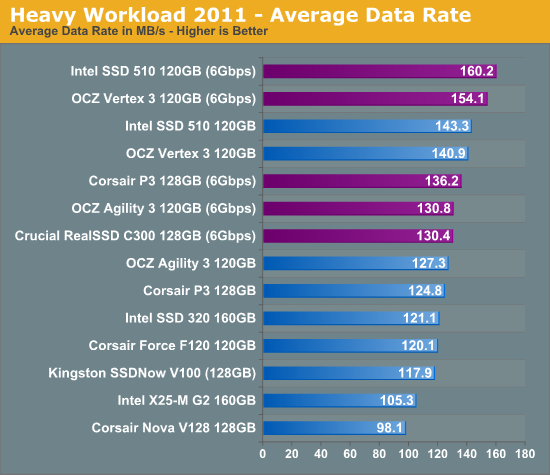
What SandForce has done with the SF-2281 controller is very impressive when you look at these results. Keep in mind that our Heavy Workload is the most write-heavy of our new benchmarks and it uses a lot of data that's already compressed (images, videos, file archives). Despite the makeup of the workload, the SF-2281 based Vertex 3 is nearly the fastest drive here - outpacing both the P3 and C300. The Agility 3, with its asynchronous NAND isn't quite as strong and is actually outpaced by Corsair's P3.
Intel's 160GB SSD 320 is a 3Gbps SATA drive and thus it can't compete with the 6Gbps offerings near the top. If we only look at 3Gbps results however, the standings aren't all that impressive. The 320, P3 and Agility 3 all fall within the same performance group, with the Vertex 3 clearly pulling ahead.
There's another drive from Intel however that does manage to impress: the Intel SSD 510. At 250GB, the 510 isn't competitive with OCZ's 240GB Vertex 3 however at 120GB the tests tell a different story. OCZ loses the ability to interleave reads/writes on a per device basis and thus takes a pretty significant performance hit. It's likely all of the incompressible data in this workload that really forces a difference between the 240GB and 120GB Vertex 3s. The 510 however doesn't have that problem, and the 120GB drive actually outperforms the Vertex 3 here. Not to mention that it should be more reliable if history is any indication.
The breakdown of reads vs. writes tells us more of what's going on:
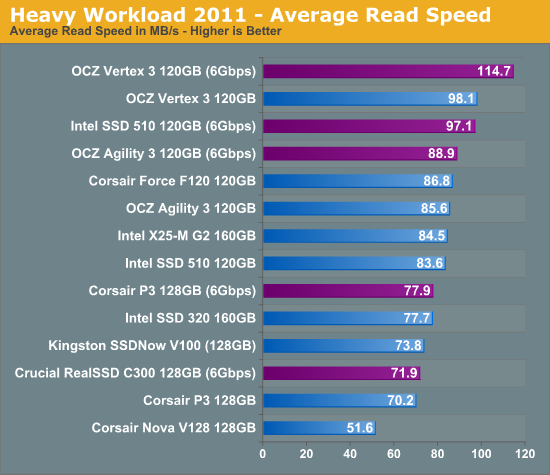
Read performance is where the Vertex 3 really makes up most of its advantage. At 114.7MB/s the Vertex 3 is nearly 30% faster than the Agility 3 here. Write speed however is a closer race between all of the drives:
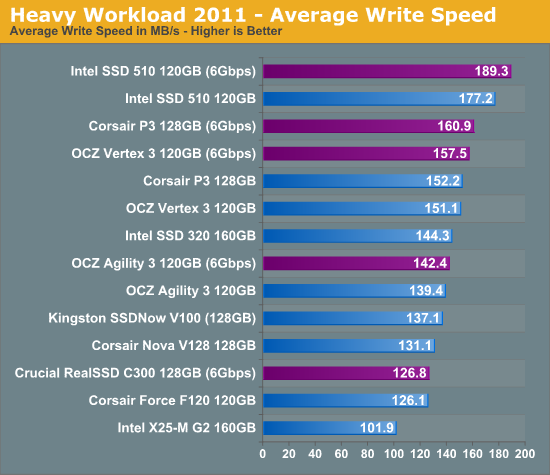
The next three charts just represent the same data, but in a different manner. Instead of looking at average data rate, we're looking at how long the disk was busy for during this entire test. Note that disk busy time excludes any and all idles, this is just how long the SSD was busy doing something:
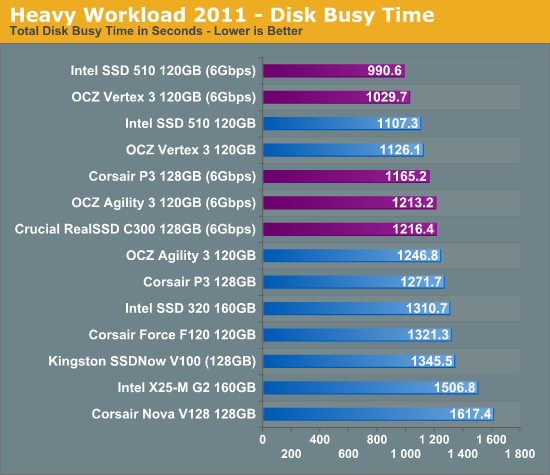
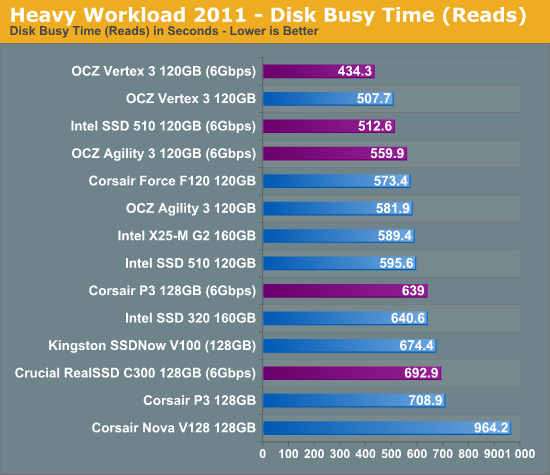











68 Comments
View All Comments
Oxford Guy - Thursday, June 9, 2011 - link
And so the 240 GB Vertex 2 would be nice to see in a review -- for perspective.jjj - Tuesday, June 7, 2011 - link
without the M4 and the MAX IOPS the comparisson is pointelss since those 2 models are the most interesting on the market atm at 120GB.dcuccia1 - Tuesday, June 7, 2011 - link
This is fantastic, thanks for the roundup. I'd love to see the same analysis at the low-end. When I build my or mom a PC with a 64GB SSD drive, I have no firm grasp on which generation of drives have the best value for a mom-style workload (word processing, music, videos, etc).SmCaudata - Tuesday, June 7, 2011 - link
Anything you can find.I have a first gen vertex 60gb that I got for $89 or something on sale before the Vertex2 drives came out. Even coming from a 1gb samsung F3 it was night and day. Outlook opens instantly and that is by far the most data intensive of the general use/productivity programs. I'm guessing music and videos will be on a separate drive anyway due to size and they play back at a fixed speed regardless so a spindle drive is just as fast for them.
So again, in summary... anything from a reputable vendor is likely going to be night and day. If you can pick up an Intel for reliability that would be a good way to go. There are some firmware issues with the c300 drives that have the potential to make them really slow, but I'm not familiar with them so I cannot speak to the specifics.
dcuccia - Wednesday, June 8, 2011 - link
Thanks, good points all around. Still, would be cool to see which drives gave a good bang for the buck for light workload systems. But you're right, at the right price it would be hard to go wrong with an old Vertex or Intel.Mr Perfect - Tuesday, June 7, 2011 - link
I'm also interested in how 64GB drives would scale, but only because they are the largest drives Intel will let you use for SSD caching. That would be completely different benchmark runs though...tecsi - Friday, July 8, 2011 - link
Yes, I have exactly the same question. What about boot/app desktop SSDs in the 40-100GB range (<$100)?Quizzical - Tuesday, June 7, 2011 - link
Are you sure that the Crucial RealSSD C300 only has 111.8 GB of usable capacity? Last July, you said that exactly the same SSD had 119.2 GB. I have the "64 GB" version of the same drive, and Windows reads it as 59.5 GB of usable capacity, so I'd expect the "128 GB" version to be around 119 GB.I don't have one, but Legit Reviews also shows the Corsair Performance 3 as having 119 GB of usable capacity, not 111.8 GB. In the past, Corsair has been inclined to do the usual hard drive manufacturer shenanigans of claiming 1 billion bytes as 1 GB, but not going beyond that and listing the total NAND flash. See the F115, which gives you about 115 billion bytes of capacity, but isn't marketed as a 128 GB drive, in spite of 128 GB of NAND flash.
Anand Lal Shimpi - Tuesday, June 7, 2011 - link
You're very correct, fixed :)Tommyv2 - Tuesday, June 7, 2011 - link
Should've waiting until you had the 120GB m4 and the 120GB Max IOPs units for review, especially with some other sites showing that the 120GB m4 actually beats out the 240GB unit in some benchmarks! Those are the two I'm most interested in, and yet there are too few reviews out there for them...